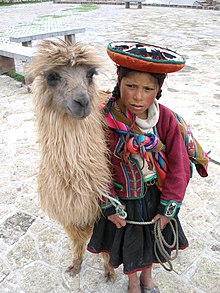
Llama hiking, also known as llama trekking or llama caravanning, is an activity where llamas accompany people on hiking and walking trips, including eco-tourism. Expeditions can last from as little as a few hours to several days. For longer trips the llamas often carry up to three days trekking supplies or cargo in purpose-built pack saddles so the people with them can carry as little as a day backpack. Treks are also offered, accompanied by the closely related alpaca.
Llamas have padded feet similar to those of a dog, which lets them easily traverse steep and rocky paths while being more environmentally friendly to the ground than horse hooves. They also can use narrower paths reducing disturbances to vegetation. Llamas have both a thick undercoat and a woolly topcoat which protects them from the cold. A three-compartment stomach helps them cope with poor quality food sources. A llama can carry about 25% of its body weight with no problem. So an average animal of 300 pounds (136 kg) can carry around 75 pounds (34 kg) of equipment in its packs.
Llamas' excellent endurance combined with biddable and peaceful natures makes them suitable pack animals for hill walking, unlike more stubborn animals such as mules. People that might not usually participate in endurance walking go llamas hiking, including couples looking for some romantic time together, or walking parties that include disabled children.
History
Llamas have been used by people of the Andes mountains as pack animals for hundreds of years. Recently, llama hiking has become popular in countries outside of South America. Since the second half of the 20th century large numbers of llamas have been brought across to the US and Canada. In southern California a few avocado farmers have used llamas to carry large loads of the fruit down steeper hills. In the UK, llamas can act as companions for a relaxing stroll, like walking a dog. Back in 1997, British newspaper The Independent described llama hiking as an exotic import from California, but it has since become more commonplace. In Wales during the 2020 COVID-19 pandemic, llamas previously used for llama hiking have been used to help deliver food and cheer up lonely people unable to get out due to the lockdown.
Therapeutic walks

Alpacas and llamas are suitable for close contact with children due to their docile and friendly natures. Parents have reported children being willing to walk twice as far when accompanied by llamas. Llama walks are a popular therapeutic activity for disabled children. Autistic children can respond especially well to llamas, sometimes the expressive eyes of the animal help them make their first sustained eye contact. According to author Kay Frydenborg, the good results llamas have with children may in part be due to how pleasant they are to touch.
See also
References
- ^ Louise Southerden, "Kaikoura's natural wonders delight on land and sea", San Francisco Chronicle, page M4, March 27, 2011.
- Rees, Paul A. (3 July 2013). Dictionary of Zoo Biology and Animal Management. John Wiley & Sons. p. 225. ISBN 978-1-118-50026-2. Retrieved 21 November 2020.
- ^ Julia Barnes, Camels and llamas at work, p. 23
- ^ Rupert Isaacsson (2007-03-23). "Head for the hills with a llama by your side; UK OUTDOORS". The Independent. Retrieved 2010-11-10.
- Michael Forsythe (2006-02-08). "Getting calmer with a llama". TVNZ. Archived from the original on 2011-06-14. Retrieved 2010-11-10.
- Camels and llamas at work By Julia Barnes, page 24.
- Llama trekking takes off, BBC, 3 June 2003
- Mathew Cantor (17 May 2020). "'Llamas are the real unicorns': why they could be our secret weapon against coronavirus". The Guardian. Retrieved 17 May 2020.
- "Coronavirus: Llamas deliver shopping to those in self-isolation". BBC. 13 May 2020. Retrieved 17 May 2020.
- Scott Graham (2006). Extreme Kids: How to Connect with Your Children Through Today's Extreme (and Not So Extreme) Outdoor Sports. Wilderness Press. pp. 162–164. ISBN 0-89997-373-6.
- Kay Frydenborg (2005). Animal Therapist. Chelsea House Publications. pp. 53–54. ISBN 0-7910-8704-2.
External links
- Llama Backpacking Documentary produced by Oregon Field Guide